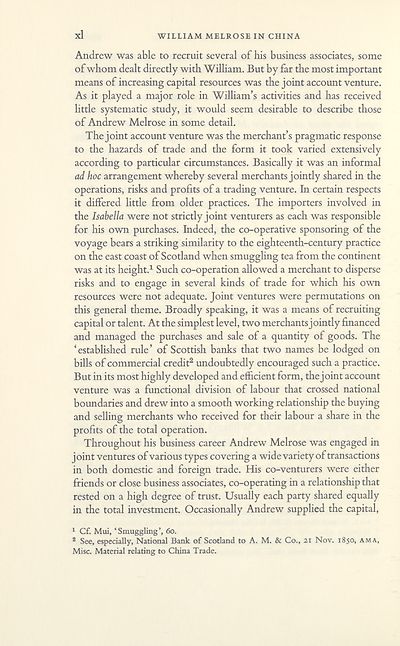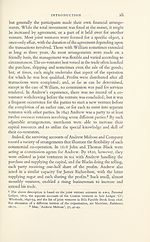Series 4 > William Melrose in China, 1845-1855
(45) Page xl
Download files
Complete book:
Individual page:
Thumbnail gallery: Grid view | List view

xl
WILLIAM MELROSE IN CHINA
Andrew was able to recruit several of his business associates, some
of whom dealt directly with William. But by far the most important
means of increasing capital resources was the joint account venture.
As it played a major role in William’s activities and has received
little systematic study, it would seem desirable to describe those
of Andrew Melrose in some detail.
The joint account venture was the merchant’s pragmatic response
to the hazards of trade and the form it took varied extensively
according to particular circumstances. Basically it was an informal
ad hoc arrangement whereby several merchants jointly shared in the
operations, risks and profits of a trading venture. In certain respects
it differed little from older practices. The importers involved in
the Isabella were not strictly joint venturers as each was responsible
for his own purchases. Indeed, the co-operative sponsoring of the
voyage bears a striking similarity to the eighteenth-century practice
on the east coast of Scotland when smuggling tea from the continent
was at its height.1 Such co-operation allowed a merchant to disperse
risks and to engage in several kinds of trade for which his own
resources were not adequate. Joint ventures were permutations on
this general theme. Broadly speaking, it was a means of recruiting
capital or talent. At the simplest level, two merchants jointly financed
and managed the purchases and sale of a quantity of goods. The
‘established rule’ of Scottish banks that two names be lodged on
bills of commercial credit2 undoubtedly encouraged such a practice.
But in its most highly developed and efficient form, the joint account
venture was a functional division of labour that crossed national
boundaries and drew into a smooth working relationship the buying
and selling merchants who received for their labour a share in the
profits of the total operation.
Throughout his business career Andrew Melrose was engaged in
joint ventures of various types covering a wide variety of transactions
in both domestic and foreign trade. His co-venturers were either
friends or close business associates, co-operating in a relationship that
rested on a high degree of trust. Usually each party shared equally
in the total investment. Occasionally Andrew supplied the capital,
1 Cf. Mui, ‘Smuggling’, 60.
2 See, especially, National Bank of Scotland to A. M. & Co., 21 Nov. 1850, ama,
Misc. Material relating to China Trade.
WILLIAM MELROSE IN CHINA
Andrew was able to recruit several of his business associates, some
of whom dealt directly with William. But by far the most important
means of increasing capital resources was the joint account venture.
As it played a major role in William’s activities and has received
little systematic study, it would seem desirable to describe those
of Andrew Melrose in some detail.
The joint account venture was the merchant’s pragmatic response
to the hazards of trade and the form it took varied extensively
according to particular circumstances. Basically it was an informal
ad hoc arrangement whereby several merchants jointly shared in the
operations, risks and profits of a trading venture. In certain respects
it differed little from older practices. The importers involved in
the Isabella were not strictly joint venturers as each was responsible
for his own purchases. Indeed, the co-operative sponsoring of the
voyage bears a striking similarity to the eighteenth-century practice
on the east coast of Scotland when smuggling tea from the continent
was at its height.1 Such co-operation allowed a merchant to disperse
risks and to engage in several kinds of trade for which his own
resources were not adequate. Joint ventures were permutations on
this general theme. Broadly speaking, it was a means of recruiting
capital or talent. At the simplest level, two merchants jointly financed
and managed the purchases and sale of a quantity of goods. The
‘established rule’ of Scottish banks that two names be lodged on
bills of commercial credit2 undoubtedly encouraged such a practice.
But in its most highly developed and efficient form, the joint account
venture was a functional division of labour that crossed national
boundaries and drew into a smooth working relationship the buying
and selling merchants who received for their labour a share in the
profits of the total operation.
Throughout his business career Andrew Melrose was engaged in
joint ventures of various types covering a wide variety of transactions
in both domestic and foreign trade. His co-venturers were either
friends or close business associates, co-operating in a relationship that
rested on a high degree of trust. Usually each party shared equally
in the total investment. Occasionally Andrew supplied the capital,
1 Cf. Mui, ‘Smuggling’, 60.
2 See, especially, National Bank of Scotland to A. M. & Co., 21 Nov. 1850, ama,
Misc. Material relating to China Trade.
Set display mode to:
![]() Universal Viewer |
Universal Viewer | ![]() Mirador |
Large image | Transcription
Mirador |
Large image | Transcription
Images and transcriptions on this page, including medium image downloads, may be used under the Creative Commons Attribution 4.0 International Licence unless otherwise stated. ![]()
| Scottish History Society volumes > Series 4 > William Melrose in China, 1845-1855 > (45) Page xl |
|---|
| Permanent URL | https://digital.nls.uk/127695117 |
|---|
| Description | Over 180 volumes, published by the Scottish History Society, containing original sources on Scotland's history and people. With a wide range of subjects, the books collectively cover all periods from the 12th to 20th centuries, and reflect changing trends in Scottish history. Sources are accompanied by scholarly interpretation, references and bibliographies. Volumes are usually published annually, and more digitised volumes will be added as they become available. |
|---|


